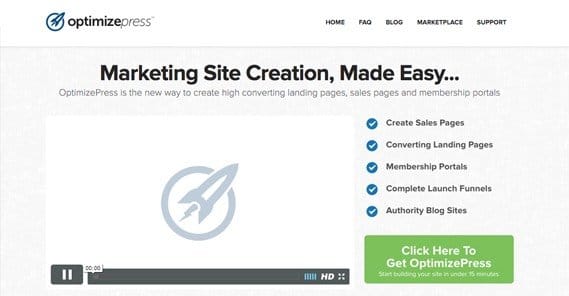5 Excellent WordPress Plugins to Create Landing Pages

When you think of WordPress, you think blog, you don’t usually think about ecommerce. If you’re familiar with WooCommerce you might realize that there are storefronts you can use with WordPress, but you’re still not likely to think about landing pages.
The thing is, WordPress is a perfectly powerful platform. You can do anything you want to with it, either with a little custom code or with custom code someone else made and released as a plugin. That’s what this post is all about, in fact; doing something you don’t normally think to do with WordPress using a plugin.
In this case, we’re talking about landing pages. If you’re running a blog, though, you might be asking; why do I need a landing page? After all, the point of a blog is to drive traffic through a every page as a landing page. People want something, they search for it, they find your blog. They’re on your site, you don’t need another page specifically for them to land on, do you?
Wishpond has covered this topic in a series of great blog posts. I’m going to link them, and then shamelessly summarize the salient points so we can move on to the real meat of this post.
- What is a Landing Page?
- Why Should I Use Landing Pages?
- When Should I Use Landing Pages?
- How Many Landing Pages do I Need?
What is a Landing Page?
In simple terms, a landing page is a hyper-focused page that is engineered around one singular objective. If you want people to sign up for a mailing list, you might create a landing page designed to promote your mailing list. It will tell people what they get for being on your mailing list, what big-name people subscribe to your mailing list, how many thousands of people are already on it, and so forth.
The trick with a landing page is the focus. Regardless of the objective, that’s the only thing in the world to the landing page. There are no navigation links to other parts of your site. There are no secondary objectives. There are no distractions. It’s just one page, one user, one objective.
Why Should You Use a Landing Page?
Why do you need hyper-focused pages? Well, that depends on what your business happens to be. Honestly, if you’re a blog with no storefront, no product, no ebook, nothing on offer but your words? You don’t need a landing page. Your site lives or dies by the quality of your content. What are you going to do, build a landing page around why people should read your blog? They can just go to your blog and see for themselves.
However, if you have any one of those things, you can use a landing page. If you have products to sell, you should have a landing page promoting those products. If you wrote an ebook and you’re trying to sell it or give it away, it should have a landing page. If you’re promoting an event, you should have a landing page for that event. Anything other than your blog text itself should have a landing page.
The fact is that landing pages convert at a much higher rate than more passive, tertiary forms of marketing. You might have sidebar ads for your ebook, but they’ll convert at a fraction of a percent, or maybe as much as 3% if you’re good. A landing page can easily convert at a 20% rate or higher.
When Should You Use Landing Pages?
Wishpond describes a few different types of landing pages.
- Long term landing pages. These are landing pages that work for an ongoing effort or evergreen content, content that isn’t going to go away and isn’t time-sensitive. This is the sort of landing page you make for a free trial, a how to guide, or a free ebook. They sit around for ages, converting in the background, for as long as they work.
- Unique channel landing pages. These are landing pages that aren’t general-issue, like an ebook landing page you link to in every blog post. They’re landing pages that take into account the source of the traffic that reaches it. A landing page designed for Google visitors and one designed for visitors from Facebook ads can be quite different.
- Segmented landing pages. These landing pages take into account the demographics of the people reaching the page. If you have five products, you’ll have landing pages for each of them, and they’ll be aimed at the sorts of people most likely to want to buy that product. For more general products, you might have one oriented at families and one oriented at individuals, for the same product. Same item, different spin.
For a more concrete answer, you should use landing pages any time you want a specific conversion action to happen. Again, any time you’re promoting a book, a product, or an event, you can have a landing page for it.
How Many Landing Pages Should You Use?
Wishpond states that studies have shown that websites with 10-15 landing pages have as many as 55% more conversions than websites with fewer than 10 landing pages. However, that doesn’t mean you can just pump out 15 landing pages and watch the traffic flow in. Depending on your business, that might have a lot of redundancy.
Essentially, it depends on your audience and your business. How many products or items do you have to sell? How many different audience demographic groups are attracted to those products?
Say you sell exactly one item, and that one item is a small shoe for girl children. Seems easy; one product, one landing page, right? Well, how about this; one landing page for mothers shopping for their daughters. One landing page for the kids themselves, that you might use as the target for in-app ads. You can even have a third landing page for if you have special offers on the product.
That’s already three landing pages for one product, and all of them play different roles. Imagine you have 15 products, or 150. You can’t make 3+ landing pages for every product, particularly when you have products that have more general appeal. You need to pick and choose the best opportunities. Rather than struggling to get 15 good landing pages ,you might be struggling to prune yourself down to that few.
Essentially, any time you have a defined purpose that you want to promote, and you have a traffic channel leading into that purpose, you want a landing page. If you don’t have active marketing pointing at the channel, you don’t need a landing page.
So, with all of that down and understood, you know why you need landing pages even on a relatively simple WordPress blog. Even if all you have is one niche ebook, that’s still worth having a landing page. So, what plugins can you use to make and maintain those landing pages?
1. Thrive Themes Landing Page Builder
Thrive Themes is one of the top-end paid WordPress plugin developers out there today, and their landing page builder is one of their best products. It has a drag and drop editor that makes it easy to create and place your content. You build your landing page the way you want it to look, and it handles the code in the background.
Thrive’s landing page builder has over 120 templates for sample landing pages you can customize. The visual editor works with any WordPress theme, though I’m not 100% sure if it works for frameworks. It supports shortcodes, too. One nice additional feature is that it supports two-step opt-in forms that pop-over when a user clicks. This combination of functionality helps build a flexible landing page with a floating CTA.
Thrive’s landing page builder comes bundled with their content builder and their lightbox plugin, all of which are quite powerful. The only downside is they are correspondingly costly. For a single site it will run you $67, or $97 for an unlimited license for as many sites as you have. The agency version for disparate client websites is $49 monthly ongoing. On the plus side, they have a 30-day no questions asked full refund if you don’t like it and can’t get help from their support.
2. OptimizePress
OptimizePress is one of the top-end plugins for optimizing pages on WordPress, and has been for years. They launched their 2.0 platform not too long ago, and it’s great. You get a whole lot of associated plugins with the system, including a membership system, a WordPress theme, and their landing page builder.
If nothing else, the membership plugin is a lot of value on its own, but added in with the other content it’s icing on the cake. The plugin has everything you need: the drag and drop editor, the membership system, the theme, a countdown timer, mobile and responsive design, 30+ templates, and two-step opt-ins. They also have a quick and easy split testing system that switches elements using scripts and records data about users with each variation in turn.
The plugin also has deep integration with a lot of additional systems. It’s fully compatible with Google analytics, Optimizely, KissMetrics, and other analytics. It has API integration with MailChimp, Aweber, Infusionsoft and more. The membership portal even works with other membership systems, like WishlistMember and MemberMouse.
Of course, it’s not all fun and games. It’s money, too. The core package, usable on up to 3 sites, is $97. If you have more sites, the $197 package allows up to 10. The top-tier package only allows 30 sites and costs $297. All of them are limited to one year of subsequent support and updates, too.
3. LeadPages
This system is unique compared to the first two because it’s not just a page creator for your site. It also has options for hosted landing pages, on the LeadPages servers. They can host your page entirely, or they can just host the content you serve up, like a PDF ebook. One of their highly advertised features, as well, is the ability to sort your list of landing pages in conversion rate order. It has an instant duplication button so you can create a variation to split test without having to recreate it. It even has the ability to convert your 404 pages into landing pages.
Everything else is similar. They have two-step opt-ins, they have 70+ templates to start from, and they have the drag and drop editor just like the other builders. Their digital asset delivery is certainly a perk, and they have some built-in analytics, so you don’t need to worry quite as much about integrating Google Analytics or keeping track of URL parameters.
LeadPages has three different packages and three different pricing models. You can pay monthly, quarterly, or on two-month cycles. With the annual monthly pricing, the lowest standard package is $25 per month, which gives you unlimited landing pages, all templates, WordPress integration, site embeds, and advanced HTML exporting. The middle package is $49 and has all that plus split testing and a few additional features, like the LeadPages affiliate program, priority email support, and the ability to upload custom templates. Finally, the top tier program is $199 monthly and includes five sub-accounts, coaching, phone support, integration with HubSpot/Marketo/Salesforce, and the template importer.
4. SeedProd Coming Soon
This is an interesting landing page plugin because it’s not really designed to make individual landing pages. Instead, it’s designed to be what you put on your site when you’re still working on developing it. It’s a landing page that sits where your homepage will eventually sit, giving people the opportunity to learn about what’s going to be on the site eventually. Typically these pages have social buttons and an email list opt-in to get people to sign up to follow along and be notified when the site launches. It can also be used in maintenance mode when you’re pulling your site down for updates; this page displays instead of a broken page.
It doesn’t have templates because ever page is essentially the same. However, higher tiers of the purchase have more background images available, and some offer premium themes. Frankly, since it’s just for launching a site, you probably don’t need more than the basic version.
5. Instapage
All of the above options are potentially expensive options, so I figure I might as well include one that’s free. This one is an active development free plugin with 10,000 active installs and a relatively high rating. It’s not the top of the top landing page plugins, but it does what you need it to do, and quickly at that.
The plugin offers 80 templates that are categorized by purpose, with the drag and drop builder they claim will take no more than three minutes to make a page with. It has integration with the usual supplementary plugins, and it does have split testing.
The caveat is that the free version only allows one page, and worse, that page is not mobile-friendly. It also conks out at 100 visitors. This is pretty restrictive, and is meant to sell the $29 monthly version, which allows unlimited pages that are mobile responsive, with a monthly visitor limit of 5,000. Other plans go up from there.
 ContentPowered.com
ContentPowered.com











